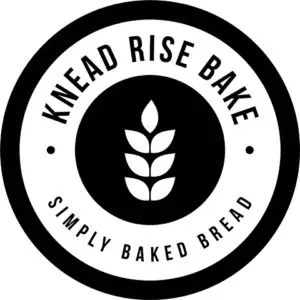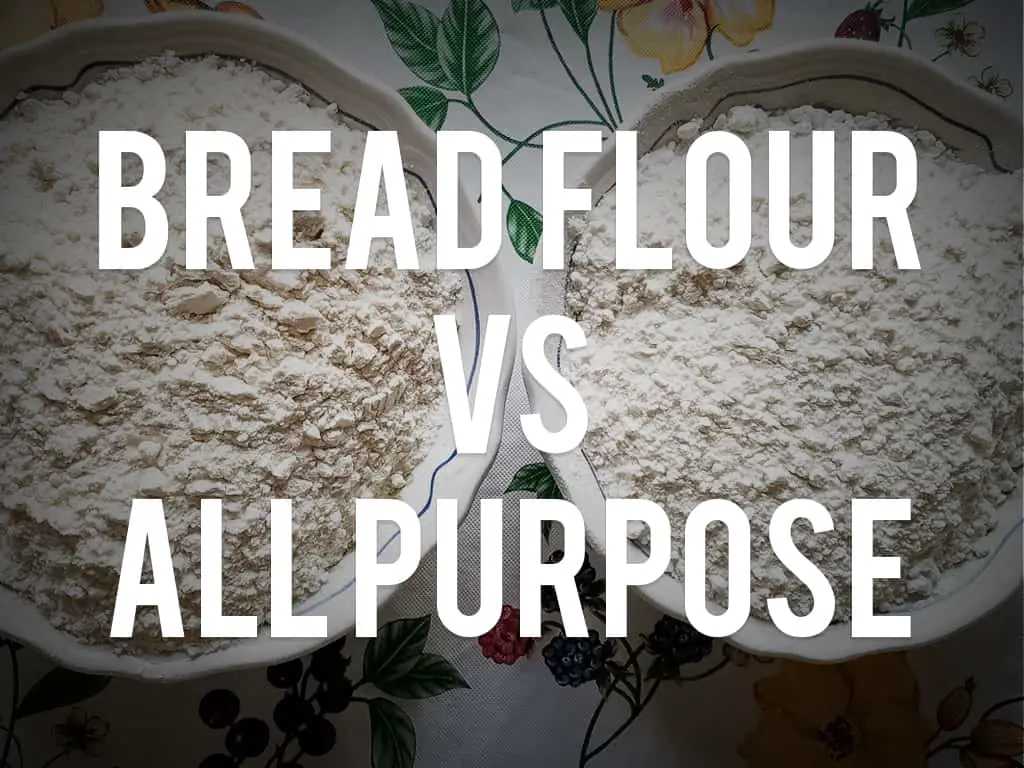To a beginning baker, the variations on different ingredients can be dizzying. White sugar vs. light brown vs. dark brown, instant yeast vs. active dry, baking soda vs baking powder…the list goes on.
Here at Knead Rise Bake, a common question we get is, what is the difference between bread flour and all-purpose flour? This is something we wondered about, too. And I’m sure for many of us, we’re actually not super interested in the differences between them on a molecular level. What we’re really wanting to know is, can these two types of flour be used interchangeably? If all I have is one, but a recipe calls for the other, can I just swap them out?
Well, we’re here to lay all that uncertainty to rest. First, to answer the basic question, what’s the difference between bread flour and all-purpose? Bread flour and all-purpose flour have different amounts of protein. Bread flour has between 12 and 14 percent protein, while all-purpose has between 8 and 11. Since more protein equals more gluten development, using bread flour in a recipe will result in a slightly better structure for bread, having more “chew”.
Depending on what you are wanting to make, this could be a good or bad thing (think banana bread vs. pizza crust). But for most baking, you can absolutely sub bread flour for all-purpose flour, or vice-versa.
Still not convinced? Let’s explore this in a bit more detail.
What’s the thing with protein?
First, I invite you to geek out with me about the science of protein. Both all-purpose (also commonly known as AP) and bread flours are types of wheat flour. Other kinds of wheat flour are whole wheat, pastry flour, self-rising, and cake flour (more on some of those other types later).
The protein in wheat flour is what causes gluten development. And gluten is what makes bread dough strong enough to trap in the air during the rising process, resulting in that fluffy, yet chewy, texture we all love so much.
Although there’s a lot that could be said about the differences between all different types of flours, I’ll do my best to stick to the topic here. As I said above, the difference between bread flour and all-purpose flour is precisely a question of protein. For flour to be labeled “bread flour”, it must have between 12% and 15% protein. Flour labeled as “all-purpose”, on the other hand”, has between 8% and 11% protein. And remember, because protein = gluten, a higher protein percentage will mean more gluten development, which will result in a stronger, chewier bread.
So, what does that mean for my recipes?
Although the different levels of protein do affect gluten development, you may have already noticed that there’s not a huge difference between the protein levels in bread and all-purpose flour. In fact, depending on the brand and bag, there might only be a 1% difference!
What this means for us home bakers is that, in bread baking especially, bread flour and all-purpose flour can be used interchangeably. There may be a slight difference in how the bread turns out, but probably nothing you would notice without doing a side-by-side comparison. (Interested in seeing one? King Arthur Flour shows us how little the difference can really be.) So if a bread recipe calls for bread flour, and you only have all-purpose (or vice-versa), don’t hesitate to take on that bake!
And here’s more good news: you can really use either type of flour in most of your home baking. Specifically, if all you have on hand is bread flour, many cookie, brownie, muffin, and quick bread recipes will work out just fine.
However, you might have noticed that I said bread flour and all-purpose can be used interchangeably in “most” baking. Here is my main caveat for the bread/all-purpose flour exchange: bread flour won’t work well for baked goods with particularly flaky or tender textures, like pie crust or cake. If all you have in the pantry is bread flour, you may just have to forgo these specific bakes.
Also, if you’re still concerned about bread flour making your baked good unpleasantly tough, something else to keep in mind is that stirring and mixing encourages gluten development. So when baking something like muffins or quick breads with bread flour, just try to mix as gently and sparingly as possible. This will minimize the effects of the higher protein percentage.
The fun thing about all this is that as you grow more confident in your baking, you can start to use these slight differences between the two types of flours to your advantage. Know that you like your pizza crust more tender than chewy? Feel free to swap out the bread flour in the recipe for AP. Enjoy extra-chewy brownies? Try making them with bread flour instead of all-purpose. I’m just recently getting to this point where I feel adventurous in my baking, and the results can be as unexpected as they are enlightening.
What about other types of flour?
We’re living in strange times, friends. What do you do if you get to the grocery store and there isn’t any bread flour or all-purpose? Let’s look over a few other common types of flour you might come across, and how you can use them in your baking.
- Cake Flour: The label of “cake flour” is also a question of protein content. Cake flour has between 5% and 8% protein. Such low protein content means much less gluten is developed in cake flour. This results in a much softer, lighter texture. Which is why cake flour is perfect for, well, cakes. It can also be used for pancakes, waffles, muffins, quick breads (like banana bread or zucchini bread), and certain types of cookies. Unfortunately, cake flour won’t work well for yeasted breads. Because of the low gluten development, the bread dough wouldn’t have enough strength to rise properly, which would result in a flat, dense loaf.
- Pastry Flour: Pastry flour has a protein percentage between that of cake and AP flours, between 8% and 9%. As it’s name implies, it’s formulated for use in pastry, such as pie crust, tarts, and some types of cookies. Use this as you would cake flour.
- Whole Wheat Flour: When wheat flour is milled, it is separated into its three main parts; the endosperm, the germ, and the bran. White flour (both AP and bread) is comprised of just the endosperm, while whole wheat has the germ and bran added back in. Whole wheat flour has a higher protein content than white, but the germ and bran can adversely affect gluten development. This means that when it comes to swapping whole wheat flour for white flour in bread recipes, some caution is needed. Usually you can sub up to half of a recipe’s white flour for whole wheat with acceptable results. If a higher percentage of the recipe is changed to whole wheat, more liquid may be needed to be added to compensate. Interestingly, though, Food 52 found that many baked goods do just fine with a full-on whole-wheat swap!
- Self-Rising Flour: Tailored for use in biscuits, scones, muffins, and pancakes, self-rising flour is made with a low-protein flour (like pastry) mixed with baking powder and salt (the baking powder is the “self-rising” part). It might take some experimenting to use self-rising flour in place of AP or bread flour because of the presence of those extra ingredients. As with pastry and cake flour, self-rising can be used in many baked goods. However, the low protein content makes it a poor candidate for bread baking.
- Bleached and Unbleached Flours: Here we have a totally different category. The term “bleached” refers to a chemical treatment that is applied to some flour to make it whiter and softer. “Unbleached” just means that flour hasn’t undergone that process. Since bleaching the flour doesn’t affect its protein level, these two types of flour can be used interchangeably. This is true whether it’s bleached/unbleached AP flour or bread flour. The one major exception is that bleached flour shouldn’t be used to feed new or weak sourdough starters, since the bleaching process strips the flour of the extra nutrients that the starter needs.
- Gluten-Free Flour: This is a broad term that refers to flour made from grains that are naturally gluten free, such as rice, corn, or buckwheat. Gluten-free flours can be purchased as individual flours (meaning, just a packet of rice flour, for example), or as a flour mix. Unless you’re using a gluten-free recipe that specifies which flours to use, it’s best to use the mix. Happily, many flour mixes can be used cup for cup in place of traditional flour. When in doubt, read the ingredient label for more detailed instructions on making the swap between the gluten-free flour and regular wheat flour.

